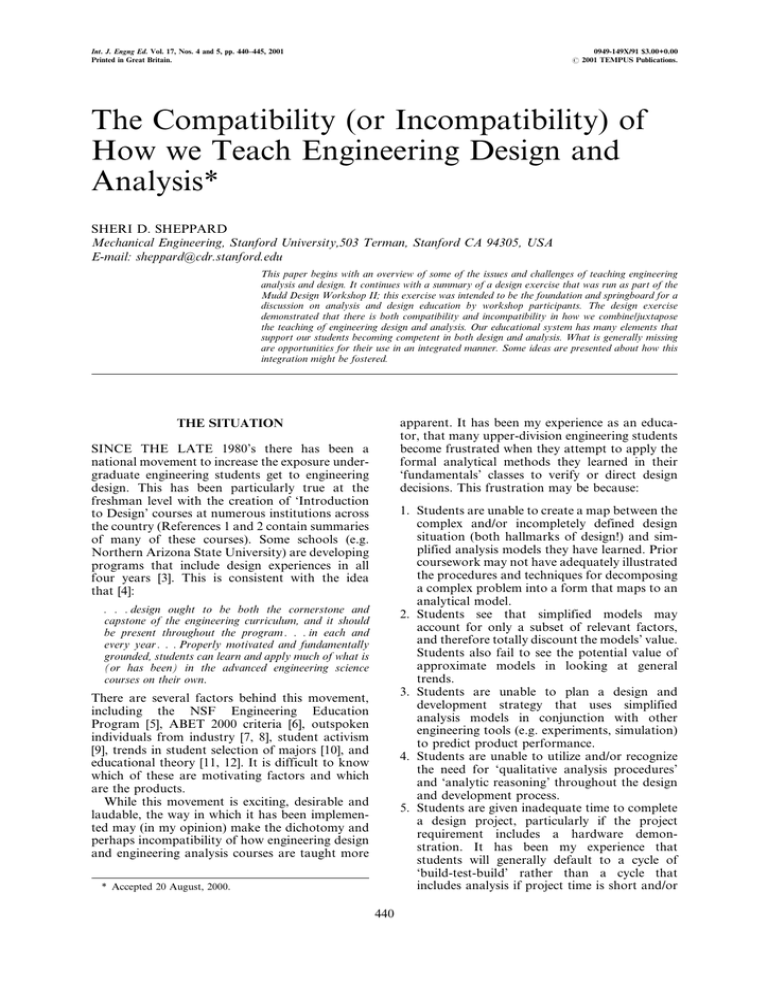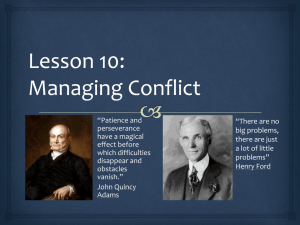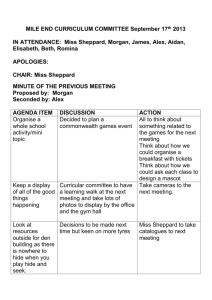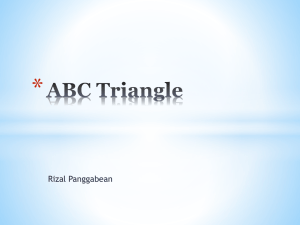The Compatibility (or Incompatibility) of How we Teach Engineering Design and Analysis*
advertisement

Int. J. Engng Ed. Vol. 17, Nos. 4 and 5, pp. 440±445, 2001 Printed in Great Britain. 0949-149X/91 $3.00+0.00 # 2001 TEMPUS Publications. The Compatibility (or Incompatibility) of How we Teach Engineering Design and Analysis* SHERI D. SHEPPARD Mechanical Engineering, Stanford University,503 Terman, Stanford CA 94305, USA E-mail: sheppard@cdr.stanford.edu This paper begins with an overview of some of the issues and challenges of teaching engineering analysis and design. It continues with a summary of a design exercise that was run as part of the Mudd Design Workshop II; this exercise was intended to be the foundation and springboard for a discussion on analysis and design education by workshop participants. The design exercise demonstrated that there is both compatibility and incompatibility in how we combine/juxtapose the teaching of engineering design and analysis. Our educational system has many elements that support our students becoming competent in both design and analysis. What is generally missing are opportunities for their use in an integrated manner. Some ideas are presented about how this integration might be fostered. apparent. It has been my experience as an educator, that many upper-division engineering students become frustrated when they attempt to apply the formal analytical methods they learned in their `fundamentals' classes to verify or direct design decisions. This frustration may be because: THE SITUATION SINCE THE LATE 1980's there has been a national movement to increase the exposure undergraduate engineering students get to engineering design. This has been particularly true at the freshman level with the creation of `Introduction to Design' courses at numerous institutions across the country (References 1 and 2 contain summaries of many of these courses). Some schools (e.g. Northern Arizona State University) are developing programs that include design experiences in all four years [3]. This is consistent with the idea that [4]: 1. Students are unable to create a map between the complex and/or incompletely defined design situation (both hallmarks of design!) and simplified analysis models they have learned. Prior coursework may not have adequately illustrated the procedures and techniques for decomposing a complex problem into a form that maps to an analytical model. 2. Students see that simplified models may account for only a subset of relevant factors, and therefore totally discount the models' value. Students also fail to see the potential value of approximate models in looking at general trends. 3. Students are unable to plan a design and development strategy that uses simplified analysis models in conjunction with other engineering tools (e.g. experiments, simulation) to predict product performance. 4. Students are unable to utilize and/or recognize the need for `qualitative analysis procedures' and `analytic reasoning' throughout the design and development process. 5. Students are given inadequate time to complete a design project, particularly if the project requirement includes a hardware demonstration. It has been my experience that students will generally default to a cycle of `build-test-build' rather than a cycle that includes analysis if project time is short and/or . . . design ought to be both the cornerstone and capstone of the engineering curriculum, and it should be present throughout the program . . . in each and every year . . . Properly motivated and fundamentally grounded, students can learn and apply much of what is (or has been) in the advanced engineering science courses on their own. There are several factors behind this movement, including the NSF Engineering Education Program [5], ABET 2000 criteria [6], outspoken individuals from industry [7, 8], student activism [9], trends in student selection of majors [10], and educational theory [11, 12]. It is difficult to know which of these are motivating factors and which are the products. While this movement is exciting, desirable and laudable, the way in which it has been implemented may (in my opinion) make the dichotomy and perhaps incompatibility of how engineering design and engineering analysis courses are taught more * Accepted 20 August, 2000. 440 The Compatibility (or Incompatibility) of How we Teach Design 441 Table 1. The design exercise Cards to the Sky ROYAL-FLUSH, Inc., an architectural and structural engineering firm, has a contract with the Bear Valley Community to design and build the community's first skyscraper structure. You work for ROYAL-FLUSH, and have been assigned to complete the project. The following design requirements have been determined for the structure: DESIGN REQUIREMENTS 1) a height of 14 inches (this may seem a bit short, but given that the average height of a Bear is 2 cm, this makes for a pretty tall building in Bear terms). 2) a platform on the top of the structure that will hold 6 Bears, for viewing lovely Bear Valley. 3) stability through a hairdryer wind at 14 inches from a westerly direction. Designs that exceed this requirement are acceptable too. 4) pleasing to look at. 5) as small a mass as possible, since the structure will be constructed off site, then trucked into the Valley for final installation. 6) construction materials: 1 standard deck of playing cards, 1 roll of tape, a pair of scissors. 7) the final structure must contain the roll of tape and the pair of scissors. 8) completed construction in 30 minutes. This may seem like a short period, but given that the life span on a Bear is only 2 days, there is no time to waste! You might want to divide your 30 minute design and construction period into approximately: 10 minutes of brainstorming and planning 15 minutes of construction and iteration. 5 minutes for preparation of a 2 minute presentation for your Bear clients. This presentation should include: ± ± ± ± ± basic design approaches your team considered what design requirements your team focused on the estimated weight of your structure proof that the structure meets the wind requirement. how your team spent its time Masses The following table should help in estimating the mass of you skyscraper: Item mass (grams) Card Box = 5.13 1 Card = 1.63 5 Cards = 8.15 10 Cards = 16.30 15 Cards = 24.45 20 Cards = 32.60 25 Cards = 40.75 30 Cards = 48.90 35 Cards = 57.05 40 Cards = 65.20 45 Cards = 73.35 50 Cards = 81.50 9) a two minute client presentation, where the design features and rationale are discussed (overhead and pen supplied) there are not explicit analysis requirements associated with the design task. Unfortunately, since they have not learned an alternative strategy to `build-test-build', as students, many engineers in industry follow this same pattern when confronted with time pressures. While this list may sound like a criticism of student abilities, it is not intended as such. It is rather offered as a criticism of how students are taught to utilize analysis tools. THE DESIGN EXERCISE The participants in the Harvey Mudd Workshop were almost all experienced design engineers and/ or engineering educators with backgrounds in teaching design. In order to tune them into the issues listed above, and facilitate discussion among them on the compatibility (or incompatibility) of today's approaches to teaching analysis and design, the participants were engaged in a 30 minute design exercise. This design exercise occurred during the opening noon session of the Workshop. It was followed by a post-exercise discussion that lasted about one hour. In this section, details of the exercise are outlined. In the next section, observations and comments from the post-exercise discussion are presented. The design exercise was crafted to meet several high level objectives; including that it serve as an `ice breaker' for the workshop; serve as a `reference' point for subsequent papers being presented on student design experiences; and (last but not least) that it serve as a springboard for further discussions on the integration of analysis and design in undergraduate engineering classes. From an engineering perspective, the exercise should present a challenge that: . is attainable (but just barely) within the time frame of the exercise; . has multiple solutions, none of which is obviously `best'; . allows (and even encourages) unconventional thinking; . has a context; . has goals that are testable and quantifiable; . has enough ambiguity to require the designers to 442 S. Sheppard interpret/define design `intent' and deal with trade-offs. The actual exercise given to the Workshop participants is presented in Table 1. A single set of materials (i.e. playing cards, tape, scissors, etc) was supplied to each team of four. Most teams were self-selected based on who they were sitting with at lunch. One team member served as the `observer' for the team, and used a pre-defined framework for making and recording observations on his or her team's design activities. The `observer' was not to participate in the design activities. During the exercise I served as a consultant, answering clarification questions posed by participants, and as a timekeeper. In addition, I wandered around the room, making my own observations on activities. . OBSERVATIONS The post-exercise discussion by participants, observer notes, and my own observations made during the exercise are summarized below. I will qualify this summary by saying that it is not intended to be comprehensive, and reflects some of my own biases regarding design, analysis and education. I have organized the summary around the goals of the exercise: . Design challenge that is attainable (but just barely) within the time frame of the exercise. Most of the eight teams felt pressured for time. All started building a tower within 15 minutes of the start of the exercise. None of the teams asked to try out the `wind load' on their design during the 30 minutes design period. (I have run a similar exercise with numerous groups, ranging in age from 10 to 70; it has been common for several groups to ask to try the hair dryer out to `get a feel' for how much air flow will be involved in the `wind loading'.) In spite of this, all of the final designs did meet the `wind load' requirement (in some cases by use of external guy wires to the table top). All designs also met the height requirement. It is not clear if all of the teams had created an overhead for presenting their design to their client (as required in the design specification); those that did, were creating it in the last minutes of the exercise. Most teams were observed to have members working in parallel (e.g. one member cutting cards, another taping them, and a third member assembling them) during the second half of the exercise. . Design challenge that has multiple solutions, none of which is obviously `best'. The skyscraper solutions varied from a single cylindrical tower, to a triangular-interlocking modules, to a design based on a `wedding cake' metaphor. While there was considerable design variation across groups, it is not clear how many design concepts were considered within a particular group. One . . . team commented that very early on in the exercise, each team member shared their image of the design (e.g. `I picture it looking like the Transamerica building in San Francisco'). Another team took the first few minutes of the exercise to read the design requirements out loud and inventory the materials before focusing on one design concept (they worked on refining and implementing this concept for the rest of the period). Another group jumped onto a single idea from the beginning. Still another team ended up modifying a design that they had been working on for most of the period during the last few minutes when it became clear that they would not finish construction before the end of 30 minutes. Design challenge that allows (and even encourages) unconventional thinking. The exercise seems to be `off-the-wall' enough to encourage unconventional thinking; there is certainly ample room for creative interpretation of what the needs are of gummy bears! After one team was assured by me that it was OK to cut and bend the playing cards, they went on to design a very unconventional skyscraper. It seems that a few people's thinking was also challenged by thinking of construction elements (e.g. scissors, tape) as engineering (e.g. counterweights) and aesthetic elements. Design challenge that has a context. The skyscraper has a reason for existing ± to serve the citizens of Bear Valley. While this is certainly `fanciful', it provides a context or `story' for the design. One team may have been put off by the overall `playfulness' of the exercise; they complained about the imprecision of the design criteria, and expressed frustration with the materials. Their reactions point to one of the challenges in designing a design exercise ± how to achieve a balance of design challenge, use of engineering principles, and fun! Design challenge that has goals that are testable and quantifiable. The exercise had some requirements that were `testable' (e.g. stands-up during the `wind load') and that were quantifiable (e.g. mass, height). There was some confusion expressed by participants on the mass requirement; was the intent to minimize mass or produce a minimum mass design? In addition, none of the participants used the mass table that was provided to all design teams to aid teams in making quick mass estimates. This may have been because the table was on the back side of the assignment sheet and they did not see it. Design challenge that has enough ambiguity to require the designers to interpret `intent', choose their own focus, and deal with trade-offs. All teams focused firstly on achieving the height and wind load requirements. There was variability as to which requirement was selected as the next priority; most chose mass, but a few chose to focus on the aesthetics and `usability' of the skyscraper by gummy bears. Several teams The Compatibility (or Incompatibility) of How we Teach Design found the words `contained', and `portability' in the requirements to be ambiguous, and asked clarification questions during design. Overall, the design exercise seemed to achieve its high-level objectives and engineering level goals. That certainly does not mean that participants did not have suggestions for its improvement. For example, it was recommended that `portability' be defined in the exercise description, the verbiage of the exercise description be reduced, and that the time for the exercise be longer. In addition, participants felt that the framework that the observer was required to use in making and recording observations was too complex. Several observers also expressed frustration at not being allowed to participate in the design. IMPLICATIONS What are the implications of this exercise to analysis and its role in design and design education? Certainly the post-exercise conversation with the participants and my own observation of their work strongly suggest that there are a number of analysis-type activities that design engineers engage in. Two will be discussed here. One of these I refer to as conventional analysis which involves formal modeling of a system. The second type I refer to as improvisational analysis. Conventional analysis involves extraction of basic elements from a design. This is the type of analysis whose results are commonly reported in the appendix of a design report. Furthermore, this is the type of analysis that is often taught in engineering science courses. Conventional analysis is particularly relevant when: . the questions being asked about a design are not easily addressed by experiments (e.g. experiment too costly, will take too much time, or is not physically possible); . the criticality of the design is such that analysis (often in conjunction with experiments) is imperative; and/or . there is incentive to optimize or justify the design. Little of this sort of analytical work was observed in the exercise. One participant commented in the discussion period, `Equations are something that people do in private'. I believe that in general, engineering education does a good job of covering the basics of conventional analysis. However, it is not clear that we teach how to conceive and execute analysis in conjunction with experiments, how to pose and frame questions to be addressed through analysis; or how to extract, define and verify an appropriate model from a real engineering system. Dixon in 1964 [13] makes similar points in saying, `Recent engineering graduates were criticized for unwillingness to consider a complete problem such as a 443 design problem. Instead they showed a desire to seek a fully specified problem which could be answered by analytical methods.' These deficiencies could in part be addressed in a series of `engineering problem solving' modules spread throughout the undergraduate experience; these modules would focus on the application of analysis methods to address engineering questions, as opposed to being focused on the execution of specific analysis methods. Doing this would put conventional analysis into a context which might better prepare student to employ it as part of design. An example of one of these modules is the freshman design course being taught by Pionke, et al. [14]; learning and practice of engineering science principles are integrated in designing and building simple structures. The second type of engineering analysis is what I will call improvisational analysis. Some might call this `back-of-the-envelope' analysis, or `engineering estimation' [15]. I use the word improvisation (or improv. for short), as this word captures the idea of `fabricating out of what is conveniently on hand' and `composing . . . extemporaneously' [16]. Participants pointed out that this sort of analysis `behavior' is grounded in a solid foundation of conventional analysis and involves posing (maybe not explicitly) questions that are addressed in the `heat of the moment'. Often the manipulation of physical materials are used to analyze the situation. For example, a card may be bent, taped and flexed about various orientations to address a question about relative stiffness; or a rough estimate of cross-sectional area might be done to estimate wind drag. This form of analysis typically leaves little written record. And this was the form of analysis that participants reported using to address questions about the performance of their design ideas. I believe that in general, engineering education does not do a consistent job of covering improv. analysis. We seldom model this behavior for our students. Furthermore, there are few opportunities for us to observe our students while they are amid their design work; it is this sort of observation that would enable us to assess and reinforce their use of improv. analysis. These deficiencies could be addressed by showing examples of the use of improv. analysis in design; for example, a videotape of a design team working might serve as a venue for a class discussion on analysis. In addition, creating a design studio environment in which our students could engage in the work of design would afford us the opportunity to observe (and reinforce) student team behaviors related to analysis. Kuhn makes similar observations in her paper on the value of learning in an architecture studio environment [17]. So is there compatibility (or incompatibility) of how we teach engineering design and analysis? The discussion above indicates that there is some compatibility and some incompatibility. It also indicates that there is a certain tension between 444 S. Sheppard educating students to be good analysts and good designers. Our educational system has many elements that support our students becoming competent in both design and analysis. What seems to be missing are many opportunities for their use in an integrated manner. A few ideas about how this integration might be fostered in our students have been offered in this paper. We are not alone in working with a certain tension between analysis and design. Consider the following quote, with the word `theory' taking the place of `analysis', and `practice' the place of `design' [18]: . . . that is, in nearly every form of professional education, students perceive the practicum experiences as truly valuable, while barely tolerating the academic experience (theoretical preparation) . . . the central feature of all professional education is indeed the tense relationship between theory and practice. It is an essential tension, as unavoidable as the tensions found within families whose members have become highly dependent on one another. It is a painful tension because theory and practice are not only competing conceptions. Different stakeholders in the social and political worlds exercise control over these domains, and any preferences given to theory over practice, or to conceptual mastery over technical proficiency, for example will have serious consequences for the future of institutions, the allocation of scarce resources, and the conferral of valued prestige. This is from an article by Lee Schulman [18], president of the Carnegie Foundation for the Advancement of Teaching. Dr. Schulman was writing on the work of John Dewey. Dewey's work (early 20th century) was focused on teacher education. It is interesting how accurately the quote describes the tensions and challenges of engineering practice and education as we approach the year 2000. It gives us pause to reflect upon the (possible) desirability of the tension An exploration of the tension between theory and practice in the professions of engineering, medicine, law, social work, and the clergy is part of a larger study currently underway at the Carnegie Foundation for the Advancement of Teaching [19]. And it gives us time to think of ways to work with it, as suggested by Dixon [13]: I think engineers who must resolve the apparent invention-analysis dichotomy should try to avoid settling out on a spot somewhere midway between the two extremes. We might better be a little schizophrenic about this and try to find a way of switching rather completely from one kind of thinking to the other as needed. Creating an engineering education system that supports and encourages this flexibility is quite a challenge. AcknowledgmentsÐI wish to thank Ed Carryer, Rolf Faste, Clive Dym, John Wesner, and Larry Leifer for many fruitful discussions about design, professional practice and design education. I also thank the participants of the Harvey Mudd Workshop who were willing to play with the exerciseÐand were willing to talk about it later. REFERENCES 1. S. D. Sheppard and R. Jenison, Freshmen engineering design experiences: an organizational framework, Int. J. Eng. Educ., 13, 3 (1997) pp. 190±197. 2. S. Sheppard, R. Jenison, A. Agogino, M. Brereton, L. Bucciarelli, J. Dally, J. Demel, C. Dym, D. Evans, R. Faste, M. Henderson, P. Minderman, J. Mitchell, A. Oladipupo, M. Piket-May, R. Quinn, T. Regan and J. Wujek, Examples of freshman design education, Int. J. Eng. Educ., 13, 4 (1997) pp. 248±261. 3. D. Larson, K. Collier, J. Hatfield and S. Howell, Student portfolios and assessment in a sequence of interdisciplinary design classes, ABET 1996 Annual Meeting, Oct. 31±Nov. 1, 1996, San Diego, CA. 4. Clive L. Dym, Learning engineering: design, languages, and experiences, J. Eng. Educ., 88, 2 (April 1999) pp. 145±148. A longer version of this paper is available on http://www2.hmc.edu/~dym/ EngrngEd.html. 5. Engineering Education Coalitions (NSF89-107). 6. ABET Engineering Criteria 2000 (EC2000), http://www.abet.org/abethomepage.html 7. J. H. McMasters and S. D. Ford, An industry view of enhancing design education, ASEE Engineering Education, 80, 5 (July/August, 1990) pp. 526±539. 8. J. H. McMasters and B. J. White, Report on the Second Boeing-University Workshop on an Industry Role in Enhancing Engineering Education, The Boeing Company, Seattle, WA, (July 18±19, 1994). 9. L. Carlson, J. Sullivan, Hands-on engineering: learning by doing in the integrated teaching and learning program, Int. J. Eng. Educ., 15, 1, pp. 20±31. 10. E. Seymour and N. Hewitt, Talking About Leaving. Factors contributing to high attrition rates among science, mathematics & engineering undergraduate majors: final report to the Alfred P. Sloan Foundation on an ethnographic inquiry at seven institutions, University of Colorado, April, (1994). 11. J. Stice, A first step toward improved teaching, Engineering Education, 66, 5, (Feb. 1976) pp. 394±398. 12. D. N. Perkins, What constructivism demands of the learner, in Constructivism and the Technology of Instruction: a conversation, LEA Associates, Hillsdale, NY, (1992) pp. 161±165. 13. J. Dixon, `Design and analysis: a conflict of interest?' J. Eng. Educ., 54, 7 (March, 1964) pp. 243±245. 14. C. Pionke, J. Parsons, J. Seat, F. Weber and D. Yoder, Balancing capability, enthusiasm, and methodology in a first year design program, accepted for J. Eng. Educ. 15. B. Linder and W. Flowers, Student responses to impromptu estimation questions, Proc. ASME Design Engineering Technical Conferences, DTM-1518, Irvine, CA, August, 1996. The Compatibility (or Incompatibility) of How we Teach Design 16. Webster's Collegiate Dictionary, (1973). 17. S. Kuhn, Learning from the architecture studio: implications for project-based pedagogy, accepted for J. Eng. Educ. 18. L. Schulman, The theory, practice and the education of professionals, Elementary School Journal, 98, 5, 1998 pp. 511±526. 19. Lee Schulman, Anne Colby, Pedagogies of the Professions: A Program for the Carnegie Foundation for the Advancement of Teaching, Oct. 9, 1998, pp. 511±528. Sheri D. Sheppard has been at Stanford University in the Design Division of Mechanical Engineering since 1986. She is an associate professor. Besides teaching both undergraduate and graduate design related classes she conducts research on weld fatigue and impact failures, fracture mechanics, and applied finite element analysis. In addition, she was co-PI with Professor Larry Leifer on a multi-university NSF grant that was critically looking at engineering undergraduate curriculum (Synthesis), and from 1997±1999 served as codirector of Stanford's Learning Lab. In 1999 she was named a fellow of the American Society of Mechanical Engineering (ASME) and the American Association for the Advancement of Science (AAAS). Dr Sheppard was recently appointed Senior Scholar at the Carnegie Foundation for the Advancement of Teaching. Her responsibilities at the Foundation focus on leading a major investigation of engineering education in the United States ± examining where it has been, where it is, and where it may be going. She will remain on the faculty of Stanford's School of Engineering in Mechanical Engineering. Before coming to Stanford, Dr Sheppard held several positions in the automotive industry, including senior research engineer at Ford Motor Company Scientific Research Lab. Her graduate work was done at the University of Michigan (1985). 445






